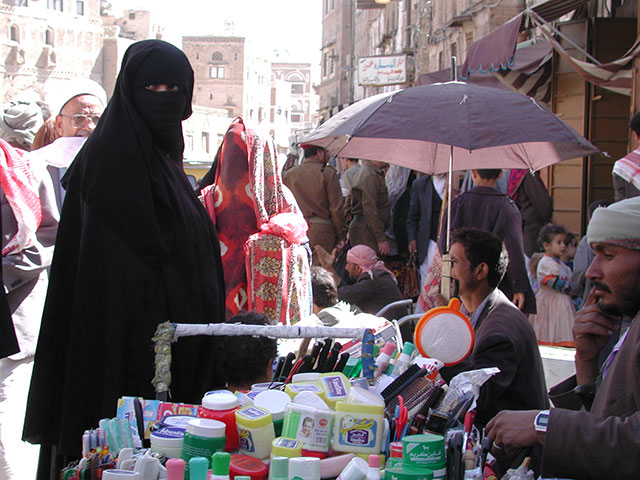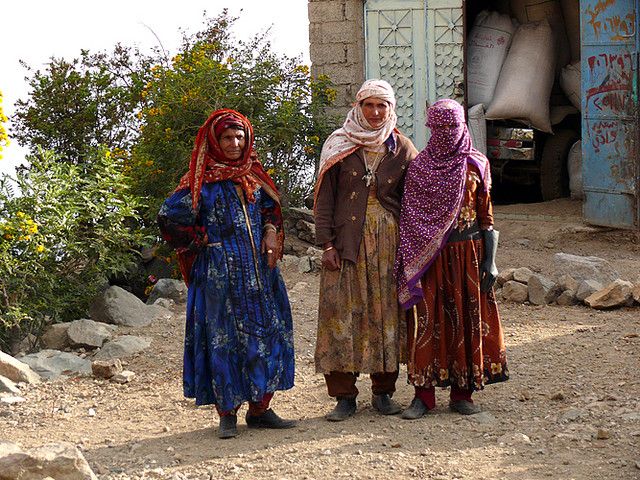Yemeni dress is a rich tapestry woven with threads of history, culture, and tradition. Each region of Yemen has developed its own distinctive style of clothing, reflecting the diverse influences and local customs that shape this ancient land. Exploring the regional variations in Yemeni dress offers a fascinating glimpse into the country’s cultural mosaic and the artistry of its people.
The North: The Elegance of Sana’a
In the northern highlands of Yemen, particularly around the historic city of Sana’a, traditional dress is characterized by its elegance and intricate detail. The men in this region typically wear the “thobe,” a long, ankle-length robe often crafted from fine cotton or wool. The thobe is usually white or cream, adorned with subtle embroidery or decorative patterns along the cuffs and collar. This garment is complemented by the “janbiya,” a curved dagger worn at the waist, which is both a symbol of honor and a practical tool.
Women in Sana’a wear the “mangha,” a traditional dress that consists of a long, loose-fitting gown. The mangha is usually adorned with elaborate embroidery, reflecting the wearer’s social status and family heritage. This attire is often paired with a “burqa,” a face-covering veil that provides modesty and protection from the elements. The detailed beadwork and embroidery on the mangha are indicative of the rich cultural heritage of the Sana’a region.
The South: The Vibrant Styles of Aden
Moving southward to the port city of Aden, Yemeni dress takes on a more vibrant and diverse character. The clothing here reflects the city’s historical role as a trading hub and melting pot of cultures. Men in Aden often wear the “sirwal,” loose-fitting trousers paired with a short tunic. This style of dress is comfortable and practical, suited to the warm coastal climate.
Women in Aden are known for their colorful and ornate attire. The “thobe” for women in this region is often brightly colored and decorated with intricate patterns and embellishments. A distinctive feature of Adenese women’s clothing is the “farshi,” a wide, flowing robe worn over the thobe, often adorned with sequins and beads. This garment is a testament to the influence of various cultures that have passed through Aden’s bustling port.
The East: The Traditional Dress of Hadhramaut
In the eastern region of Yemen, particularly in Hadhramaut, traditional dress takes on a more conservative and refined appearance. Men wear the “futah,” a traditional wrap-around skirt that is often paired with a long shirt or tunic. The futah is usually made from lightweight fabric to accommodate the hot desert climate and is often worn with a “kumma,” a small, embroidered cap.
Women in Hadhramaut wear the “abaya,” a long, black cloak that covers their entire body, paired with a “niqab,” a face-covering veil. The abaya is often adorned with subtle embroidery or embellishments, reflecting the region’s conservative values and emphasis on modesty. The Hadhramaut dress style emphasizes simplicity and elegance, aligned with the traditional values of the region.
The West: The Fusion of Traditional and Modern Styles
The western regions of Yemen, including Taiz and Hodeidah, showcase a fusion of traditional and modern influences in their dress styles. Men often wear a combination of the thobe and sirwal, blending elements from various regional styles. The thobe in this region may feature modern patterns or colors, reflecting contemporary fashion trends while maintaining traditional roots.
Women in the western regions also exhibit a blend of old and new in their clothing. The traditional mangha and burqa are sometimes paired with more modern accessories or fabrics, creating a unique style that bridges the gap between tradition and contemporary fashion. This fusion is a testament to the adaptability and resilience of Yemeni culture in the face of changing times.

The Influence of Religion and Social Customs
Throughout Yemen, the influence of religion and social customs plays a significant role in shaping traditional dress. Islamic principles of modesty and propriety are reflected in the clothing choices of both men and women across different regions. While each area has its unique styles and preferences, the overarching themes of modesty and respect for cultural traditions remain consistent.
For instance, the practice of wearing the burqa or niqab, prevalent in many regions, underscores the importance of modesty in Yemeni culture. Similarly, the elaborate embroidery and intricate designs found in regional clothing often serve as symbols of family heritage and social status.
Preserving Tradition in a Changing World
As Yemen faces modern challenges and influences, there is a growing movement to preserve and celebrate traditional dress. Artisans and cultural enthusiasts are working to ensure that the rich heritage of Yemeni clothing is maintained for future generations. This effort involves not only preserving traditional techniques but also adapting them to contemporary tastes and contexts.
Organizations and initiatives dedicated to Yemeni cultural preservation are increasingly focusing on the artistry of traditional dress. They are documenting and showcasing the diverse styles from various regions, promoting an appreciation for the craftsmanship and cultural significance behind each garment.
Conclusion
Exploring the regional variations in Yemeni dress reveals a vibrant and diverse cultural heritage that spans centuries. From the elegant thobes of Sana’a to the colorful attire of Aden and the refined abayas of Hadhramaut, each region of Yemen offers a unique glimpse into the country’s rich traditions and history. As Yemen navigates the complexities of the modern world, the preservation and celebration of its traditional dress remain vital in maintaining the country’s cultural identity and heritage. Through these garments, the story of Yemen’s past, present, and future continues to unfold, thread by thread.


